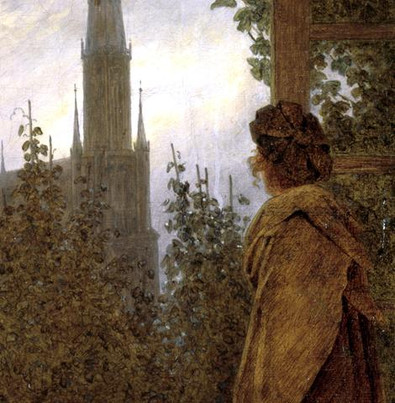
Caspar David Friedrich, born 5 September 1774, was a 19th-century German Romantic landscape painter, generally considered the most important German artist of his generation. He is best known for his mid-period allegorical landscapes which typically feature contemplative figures silhouetted against night skies, morning mists, barren trees or Gothic ruins. His primary interest was the contemplation of nature, and his often symbolic and anti-classical work seeks to convey a subjective, emotional response to the natural world. Friedrich's paintings characteristically set a human presence in diminished perspective amid expansive landscapes, reducing the figures to a scale that, according to the art historian Christopher John Murray, directs "the viewer's gaze towards their metaphysical dimension".
The visualisation and portrayal of landscape in an entirely new manner was Friedrich's key innovation. He sought not just to explore the blissful enjoyment of a beautiful view, as in the classic conception, but rather to examine an instant of sublimity, a reunion with the spiritual self through the contemplation of nature.
Friedrich was instrumental in transforming landscape in art from a backdrop subordinated to human drama to a self-contained emotive subject. Friedrich's paintings commonly employed the Rückenfigur—a person seen from behind, contemplating the view. The viewer is encouraged to place himself in the position of the Rückenfigur, by which means he experiences the sublime potential of nature, understanding that the scene is as perceived and idealised by a human.
Friedrich created the notion of a landscape full of romantic feeling—die romantische Stimmungslandschaft. His art details a wide range of geographical features, such as rock coasts, forests, and mountain scenes. He often used the landscape to express religious themes. During his time, most of the best-known paintings were viewed as expressions of a religious mysticism. Friedrich said:
"The artist should paint not only what he sees before him, but also what he sees within him. If, however, he sees nothing within him, then he should also refrain from painting that which he sees before him. Otherwise, his pictures will be like those folding screens behind which one expects to find only the sick or the dead."
Expansive skies, storms, mist, forests, ruins and crosses bearing witness to the presence of God are frequent elements in Friedrich's landscapes. Though death finds symbolic expression in boats that move away from shore—a Charon-like motif—and in the poplar tree, it is referenced more directly in paintings like The Abbey in the Oakwood (1808–10), in which monks carry a coffin past an open grave, toward a cross, and through the portal of a church in ruins.

He was one of the first artists to portray winter landscapes in which the land is rendered as stark and dead. Friedrich's winter scenes are solemn and still—according to the art historian Hermann Beenken, Friedrich painted winter scenes in which "no man has yet set his foot. The theme of nearly all the older winter pictures had been less winter itself than life in winter. In the 16th and 17th centuries, it was thought impossible to leave out such motifs as the crowd of skaters, the wanderer... It was Friedrich who first felt the wholly detached and distinctive features of a natural life. Instead of many tones, he sought the one; and so, in his landscape, he subordinated the composite chord into one single basic note".
Bare oak trees and tree stumps, such as those in Raven Tree (c. 1822), Two Men Contemplating the Moon (c. 1820), and Willow Bush under a Setting Sun (c. 1835), are recurring elements of Friedrich's paintings, symbolizing death. Countering the sense of despair are Friedrich's symbols for redemption: the cross and the clearing sky promise eternal life, and the slender moon suggests hope and the growing closeness of Christ. In his paintings of the sea, anchors often appear on the shore, also indicating a spiritual hope.
German literature scholar Alice Kuzniar finds in Friedrich's painting a temporality—an evocation of the passage of time—that is rarely highlighted in the visual arts. For example, in The Abbey in the Oakwood, the movement of the monks away from the open grave and toward the cross and the horizon imparts Friedrich's message that the final destination of man's life lies beyond the grave.
With dawn and dusk constituting prominent themes of his landscapes, Friedrich's own later years were characterized by a growing pessimism. His work becomes darker, revealing a fearsome monumentality. The Wreck of the Hope—also known as The Polar Sea or The Sea of Ice (1823–24)—perhaps best summarizes Friedrich's ideas and aims at this point, though in such a radical way that the painting was not well received. Completed in 1824, it depicted a grim subject, a shipwreck in the Arctic Ocean;
"the image he produced, with its grinding slabs of travertine-coloured floe ice chewing up a wooden ship, goes beyond documentary into allegory: the frail bark of human aspiration crushed by the world's immense and glacial indifference."

Friedrich's written commentary on aesthetics was limited to a collection of aphorisms set down in 1830, in which he explained the need for the artist to match natural observation with an introspective scrutiny of his own personality. His best-known remark advises the artist to "close your bodily eye so that you may see your picture first with the spiritual eye. Then bring to the light of day that which you have seen in the darkness so that it may react upon others from the outside inwards." He rejected the overreaching portrayals of nature in its "totality", as found in the work of contemporary painters like Adrian Ludwig Richter and Joseph Anton Koch.
Both Friedrich's life and art have at times been perceived by some to have been marked with an overwhelming sense of loneliness. Art historians and some of his contemporaries attribute such interpretations to the losses suffered during his youth to the bleak outlook of his adulthood, while Friedrich's pale and withdrawn appearance helped reinforce the popular notion of the "taciturn man from the North".

Alongside other Romantic painters, Friedrich helped position landscape painting as a major genre within Western art. Of his contemporaries, Friedrich's style most influenced the painting of Johan Christian Dahl. Among later generations, Arnold Böcklin was strongly influenced by his work, and the substantial presence of Friedrich's works in Russian collections influenced many Russian painters, in particular Arkhip Kuindzhi and Ivan Shishkin.
On the right is a painting by Ivan Shishkin: In the Wild North, painted in 1891, over 50 years after Friedrich's death.
Friedrich was a prolific artist who produced more than 500 attributed works. In line with the Romantic ideals of his time, he intended his paintings to function as pure aesthetic statements, so he was cautious that the titles given to his work were not overly descriptive or evocative. Complications arise when dating Friedrich's work, in part because he often did not directly name or date his canvases. He kept a carefully detailed notebook on his output, however, which has been used by scholars to tie paintings to their completion dates.
Friedrich's reputation as an artist suffered throughout the 20th century, his worked twisted and used in the promotion of Nazi ideology and a cutting summary by art historian Kenneth Clark which suggested that the artist was trying to express in painting what is best left to poetry. Friedrich's reputation suffered further damage when his imagery was adopted by a number of Hollywood directors, such as Walt Disney, built on the work of such German cinema masters as Fritz Lang and F. W. Murnau, within the horror and fantasy genres.
His rehabilitation was slow, but enhanced through the writings of such critics and scholars as Werner Hofmann, Helmut Börsch-Supan and Sigrid Hinz, who successfully rejected and rebutted the political associations ascribed to his work, and placed it within a purely art-historical context. By the 1970s, he was again being exhibited in major galleries across the world, as he found favour with a new generation of critics and art historians.
Today, his international reputation is well established. He is a national icon in his native Germany, and highly regarded by art historians and art connoisseurs across the Western World. He is generally viewed as a figure of great psychological complexity, and according to William Vaughan:
"a believer who struggled with doubt, a celebrator of beauty haunted by darkness. In the end, he transcends interpretation, reaching across cultures through the compelling appeal of his imagery. He has truly emerged as a butterfly—hopefully one that will never again disappear from our sight".









































































































































































Comments